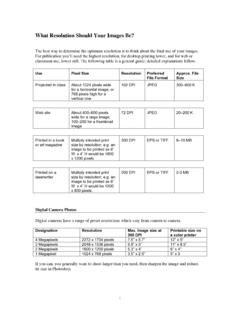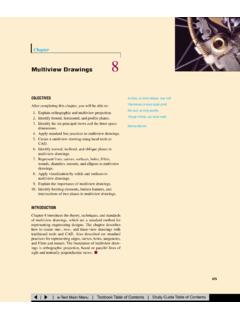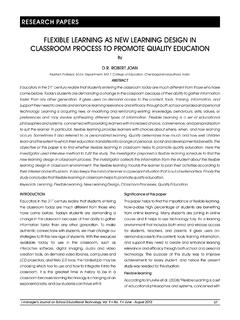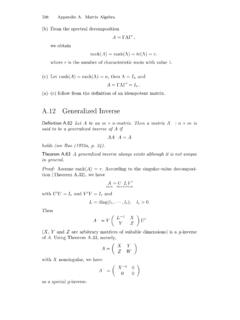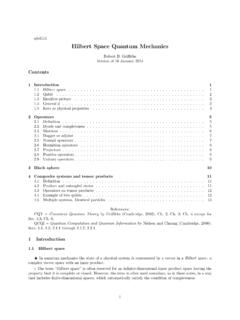Transcription of 1 Vector spaces and dimensionality - MIT OpenCourseWare
1 LINEAR ALGEBRA: Vector spaces AND OPERATORS B. Zwiebach October 21, 2013 Contents 1 Vector spaces and dimensionality 1 2 Linear operators and matrices 5 3 Eigenvalues and eigenvectors 11 4 Inner products 14 5 Orthonormal basis and orthogonal projectors 18 6 Linear functionals and adjoint operators 20 7 Hermitian and Unitary operators 24 1 Vector spaces and dimensionality In quantum mechanics the state of a physical system is a Vector in a complex Vector space. Observables are linear operators, in fact, Hermitian operators acting on this complex Vector space. The purpose of this chapter is to learn the basics of Vector spaces , the structures that can be built on those spaces , and the operators that act on them. Complex Vector spaces are somewhat different from the more familiar real Vector spaces .
2 I would say they have more powerful properties. In order to understand more generally complex Vector spaces it is useful to compare them often to their real dimensional friends. We will follow here the discussion of the book Linear algebra done right, by Sheldon Axler. In a Vector space one has vectors and numbers. We can add vectors to get vectors and we can multiply vectors by numbers to get vectors. If the numbers we use are real, we have a real Vector space. If the numbers we use are complex, we have a complex Vector space. More generally, the numbers we use belong to what is called in mathematics a field and denoted by the letter F. We will discuss just two cases,F = R, meaning that the numbers are real, and F = C, meaning that the numbers are complex.
3 The definition of a Vector space is the same for F being R or C. A Vector space V is a set of vectors with an operation of addition (+) that assigns an element u + v V to each u, v V. This means that V is closed under addition. There is also a scalar multiplication by elements of F, with av V 1 for any a F and v V. This means the space V is closed under multiplication by numbers. These operations must satisfy the following additional properties: 1. u + v = v + u V for all u, v V (addition is commutative). 2. u + (v + w) = (u + v) +w and (ab)u = a(bu) for any u, v, w V and a, b F (associativity). 3. There is a Vector 0 V such that 0 + u = u for all u V (additive identity). 4. For each v V there is a u V such that v + u = 0 (additive inverse). 5. The element 1 F satisfies 1v = v for all v V (multiplicative identity).
4 6. a(u+v) = au +av and (a+b)v = av +bv for every u, v V and a, b F (distributive property). This definition is very efficient. Several familiar properties follow from it by short proofs (which we will not give, but are not complicated and you may try to produce): The additive identity is unique: any Vector 0 that acts like 0 is actually equal to 0. 0v = 0, for any v V, where the first zero is a number and the second one is a Vector . This means that the number zero acts as expected when multiplying a Vector . a0 = 0, for any a F. Here both zeroes are vectors. This means that the zero Vector multiplied by any number is still the zero Vector . The additive inverse of any Vector v V is unique. It is denoted by v and in fact v = ( 1)v.
5 We must emphasize that while the numbers, in F are sometimes real or complex, we never speak of the vectors themselves as real or complex. A Vector multiplied by a complex number is not said to be a complex Vector , for example! The vectors in a real Vector space are not themselves real, nor are the vectors in a complex Vector space complex. We have the following examples of Vector spaces : 1. The set of N-component vectors a1 a2 .. , ai R , i = 1,2, .. N . ( ) aN form a real Vector space. 2. The set of M N matrices with complex entries a11 .. a1N a21 .. a2N ,aij C , ( ) .. aM1 .. aM N 2 is a complex Vector space. In here multiplication by a constant multiplies each entry of the matrix by the constant. 3. We can have matrices with complex entries that naturally form a real Vector space.
6 The space of two-by-two hermitian matrices define a real Vector space. They do not form a complex Vector space since multiplication of a hermitian matrix by a complex number ruins the hermiticity. 4. The set P(F) of polynomials p(z). Here the variable z F and p(z) F. Each polynomial p(z) has coefficients a0, a1, .. an also in F: 2 n p(z) = a0 + a1z + a2z + .. + anz . ( ) By definition, the integer n is finite but it can take any nonnegative value. Addition of poly nomials works as expected and multiplication by a constant is also the obvious multiplication. The space P(F) of all polynomials so defined form a Vector space over F. 5. The set F of infinite sequences (x1, x2, ..) of elements xi F. Here (x1, x2, ..) + (y1, y2, ..) = (x1 + y1, x2 + y2, ..) ( ) a(x1, x2.)
7 = (ax1, ax2, ..) a F . This is a Vector space over F. 6. The set of complex functions on an interval x [0, L], form a Vector space overC. To better understand a Vector space one can try to figure out its possible subspaces. A subspace of a Vector space V is a subset of V that is also a Vector space. To verify that a subset U of V is a subspace you must check that U contains the Vector 0, and that U is closed under addition and scalar multiplication. Sometimes a Vector space V can be described clearly in terms of collection U1, U2, .. Um of sub- spaces of V. We say that the space V is the direct sum of the subspaces U1, U2, .. Um and we write V = U1 U2 Um ( ) if any Vector in V can be written uniquely as the sum u1 + u2 + .. + um, where ui Ui.
8 To check uniqueness one can, alternatively, verify that the only way to write 0 as a sum u1 +u2 +.. +um with ui Ui is by taking all ui s equal to zero. For the case of two subspaces V = U W, it suffices to prove that any Vector can be written as u + w with u U and w W and that U W = 0. Given a Vector space we can produce lists of vectors. A list (v1, v2, .. , vn) of vectors in V contains, by definition, a finite number of vectors. The number of vectors in the list is the length of the list. The span of a list of vectors (v1, v2, vn) in V, denoted as span(v1, v2, , vn), is the set of all linear combinations of these vectors a1v1 + a2v2 + .. anvn ,ai F ( ) 3 A Vector space V is spanned by a list (v1, v2, vn) if V = span(v1, v2, vn). Now comes a very natural definition: A Vector space V is said to be finite dimensional if it is spanned by some list of vectors in V.
9 If V is not finite dimensional, it is infinite dimensional. In such case, no list of vectors from V can span V. Let us show that the Vector space of all polynomials p(z) considered in Example 4 is an infinite dimensional Vector space. Indeed, consider any list of polynomials. In this list there is a polynomial of maximum degree (recall the list is finite). Thus polynomials of higher degree are not in the span of the list. Since no list can span the space, it is infinite dimensional. For example 1, consider the list of vectors (e1, e2, .. eN ) with 0 1 0 1 00 1 This list spans the space (the Vector displayed is a1e1 + a2e2 + .. aN eN ). This Vector space is finite dimensional. A list of vectors (v1, v2, .. , vn), withvi V is said to be linearly independent if the equation a1v1 + a2v2 +.
10 + anvn = 0, ( ) only has the solution a1 = a2 = = an = 0. One can show that the length of any linearly independent list is shorter or equal to the length of any spanning list. This is reasonable, because spanning lists can be arbitrarily long (adding vectors to a spanning list gives still a spanning list), but a linearly independent list cannot be enlarged beyond a certain point. Finally, we get to the concept of a basis for a Vector space. A basis of V is a list of vectors in V that both spans V and it is linearly independent. Mathematicians easily prove that any finite dimensional Vector space has a basis. Moreover, all bases of a finite dimensional Vector space have the same length. The dimension of a finite-dimensional Vector space is given by the length of any list of basis vectors.












